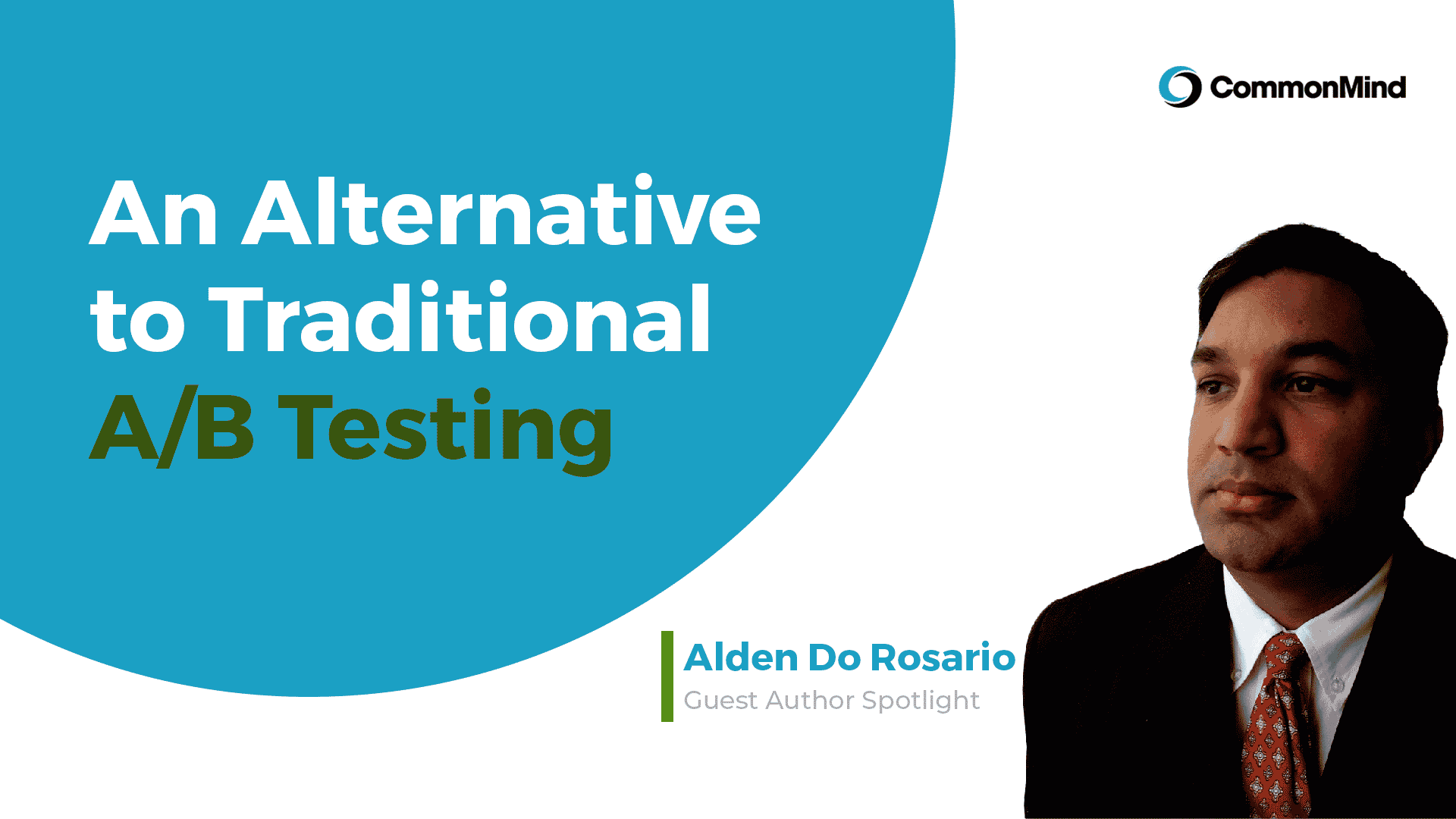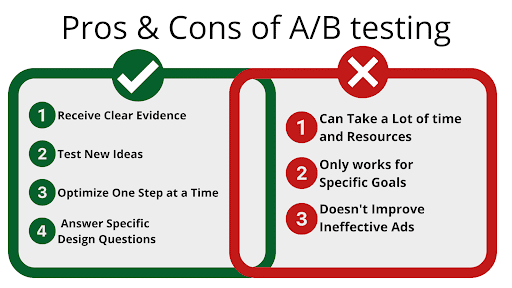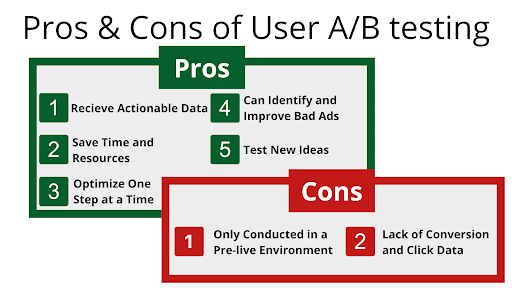A/B Test Stuck in Neutral? Try This Optimization Tactic

Companies frequently use A/B testing to compare different versions of their product, ad, website, or prototypes to see which is performing better. Many A/B testing resources recommend that such tests should be run over a long period of time so that they can gather statistically significant results.
While getting more data over a long period of time sounds like a great plan, this could give rise to some issues around the way the data was collected, a restriction of your budget, or a need for faster results.
Too often, small and medium-sized businesses can run into roadblocks that cause a test to get stuck—without ever receiving enough data to validate a decision.
Why Do Traditional A/B Tests Get Stuck?
Unless you are an A/B testing and CRO expert, you might not have noticed that a lot of A/B tests will get stuck, never receiving enough volume to choose a winner or finish without conclusive data. You might have experienced some disappointment if you’ve tried A/B testing but didn’t get the data you wanted.
Unfortunately, this is a very common issue. When an A/B test is run in a competitive environment that requires a large budget to get clicks or interactions, a test might get stuck. Additionally, if a small business has a hard time getting enough traffic to gather data for the test, they might be waiting weeks or months for the results.
If you want to optimize your A/B testing strategy, find the best headlines, and build your best creative, here is a new approach your team can try the next time an A/B test gets stuck.
The Alternative to Traditional A/B Testing
Traditional A/B testing, in a live environment, has been the most popular way to validate decisions and understand what resources you should focus on. But what if your website, ads, or prototypes don’t have enough traffic? Or if your organization refuses to justify the cost of A/B testing? There are many marketers, researchers, and businesses that face this scenario.
You can either play a guessing game and hope that your optimization efforts will be successful, or you can use new qualitative and budget-friendly methods to turn the guessing game into an analytical process.
The optimization tactic covered here won’t provide the same level of statistical validity offered by well-executed A/B tests. However, this method can help you avoid making changes based on gut instinct. Additionally, it will help optimize your resources with real, actionable insights. This optimization strategy relies on gathering quality user feedback that will then drive changes in design, copy, funnels, prototypes, and more.
- If your A/B test is stuck in neutral, rapid user testing is one of the most commonly used qualitative research methods.
- User testing is a technique used in user-centered design to evaluate a product by testing it on real people to gather feedback. Marketing professionals have reported that just 5 user tests can reveal 80% of usability issues.
- A rapid user test can provide much of the same data as a live A/B test with the added benefit of qualitative data.
If you need to understand the why, not just the what, of your design process—and are running tests on a low-traffic website or environment—a qualitative user test is the best option.
In order to develop a thorough understanding of users at each level of development, today’s modern, agile teams need access to rapid user feedback. Instead of waiting weeks with a live A/B test, remote-user testing provides similar data in a fraction of the time—for a fraction of the cost.
The Benefits of Rapid, Feedback-Based A/B Testing
Rapid user testing’s biggest benefit in this scenario is its ability to eliminate roadblocks that occur in high CPC and low volume environments when A/B testing. The process allows you to gather feedback in just hours—and ensure the test creates statistical significance. The following are some of the most impactful benefits of implementing a user-based A/B testing strategy.
Draft data-backed decisions
Each time you run a test and use the results to inform decisions, you are making smart improvements based on the opinion, interactions, and feedback of users. Utilizing this testing method ensures you are running the ads that the audience connects with the most.
A user-based A/B test will not only eliminate the issues posed by live A/B testing, but will also help an organization better understand user needs and expectations. By providing quantitative and qualitative data, you can validate decisions with statistics from participants. Testing reveals which ad or design is the most popular, allowing you to launch the right design.
Understand your target audience
Through user A/B testing, researchers can understand how the target audience interacts with ads and identify the variations that resonate. Targeting and applying advanced criteria to the testing audience creates tests that gather feedback from the users that are most likely to view your resources once they are live.
Save time and money
User A/B testing as an alternative to or accompaniment of a traditional A/B test will save time and money.
- In high CPC environments, a live A/B test could cost hundreds or thousands. User A/B testing requires a fraction of that investment, and enables smaller organizations to focus budget elsewhere.
- If you create and implement a user A/B testing process, you will identify ways to optimize designs with feedback from real users. Identifying issues with ads, websites, or other elements of the business before launch will save time and money in development and rework.
- Traditional A/B tests often get stuck in neutral or take weeks to complete. Fast user feedback is valuable, allowing teams to identify problem areas, most important elements of a design, and allot additional time to optimize.
Iterate quickly
By frequently conducting user A/B testing, you can identify the ad and design direction that create traffic and convert users. With rapid feedback testing and retesting, you can be done in hours instead of weeks. This helps small businesses to allocate design spend wisely.
Adding user A/B testing to your marketing toolkit helps your organization gather actionable data—without the need for a large budget or extensive time dedicated to research.
How to Conduct a User A/B Test
User A/B testing provides a method for understanding what works and what doesn’t. An effective testing program can increase conversions, profit, and other desired goals by understanding the most impactful areas to optimize. A/B testing is no longer just a post-launch, once-in-a-while activity—it is a structured and ongoing process that can be conducted before launching concepts, features, or other material.
While user A/B testing is not as widely known or popular as live A/B testing, it is just as effective for small-scale businesses looking to grow and simple to conduct. However, a researcher must follow a few crucial steps when conducting these tests.
Step 1: Choose a testing platform
There are several effective platforms that allow organizations to test their resources quickly and effectively. A few of the best platforms are PollthePeople.app, UserTesting.com, and UserBrain.com.
- All of these platforms can conduct user tests in hours and provide high-quality feedback.
- Each has a built-in user panel enabling businesses to choose the number of participants they want to test with as well as apply advanced criteria and segmentation.
- These self-service systems offer plans that allow businesses of any size to optimize with user feedback. There is often no need for coding or design experience as they are equipped with templates and test designs that are simple to use.
- Additionally, they will display the feedback and data in a results dashboard to easily analyze and understand the outcome.
Step 2: Select a template and launch
To easily implement and design your test, you should choose the template that matches the resources you are testing. The most common templates for SEM professionals are Google ads, Facebook ads, and ad copy templates.
- Once you have your design variations uploaded, create test scenarios or questions to help achieve the testing goals and validate the hypothesis.
- Ask users to complete tasks and provide feedback comparing and analyzing their experiences with each design.
- The right testing platforms have built-in user panels that represent the users that would see your ads in a live environment.
- Most platforms offer audience segmentation and advanced criteria to target participants in specific demographics and groups.
Before you launch a test, it is important to review whether it is designed effectively: review the resources you are testing, the scenarios and questions for participants, and the audience you have identified for the test. Once you have confirmed the test is set up how it needs to be, launch the test and wait for the results.
Step 3: Analyze results and make changes
Most user A/B tests provide both qualitative and quantitative data to understand the what and the why of the test. Your team will be able to filter responses, share data, and find actionable insights to optimize your business strategies moving forward.
- It is important to understand all of the data that is gathered to fully understand the results of the test.
- Each respondent will provide feedback on their experiences to educate your decisions and help your team run the best ads possible.
- Based on the version that won the test, along with the qualitative data, you can make changes to designs that meet user needs.
Rapid user A/B testing eliminates uncertainty from the creation and implementation of new resources. An organization can create better ads with the confidence that their designs will satisfy their customers and generate new ones..
Comparing Live A/B Testing and User A/B Testing
Traditional A/B testing executed effectively is one of the best ways to validate design direction and gather data, but a lot of researchers—especially those in growing organizations—run into budget and time restrictions. When a live A/B test gets stuck in neutral, user A/B testing can be an effective tactic to gather feedback in less time at a lower cost.
Each testing method has benefits that help optimize designs and drawbacks that can cause bottlenecks. Determining which style is right for your business will depend on your unique needs as a company. Compare the pros and cons of each testing method below to find the best fit.

The Pros of Live A/B Testing
It’s easy to see how many users click on an ad or convert into a lead with traditional A/B testing. The evidence is based on real, live behaviors, providing clear evidence that one version is more effective than the other.
Test new ideas
If you have a new approach in mind for an existing campaign, this form of A/B testing provides proof that your assumptions are correct. You can experiment with new concepts or designs to understand if they will be effective and improve your ROI.
Optimize one step at a time
Live A/B testing allows organizations that run large ad campaigns to find the best direction and identify the elements that have the greatest impact. An enterprise-level organization can benefit from testing small parts of the ads and then working up to the overall design.
Answer specific design questions
If you are trying to understand if the order of your headlines changes ad effectiveness or if the color of your creative increases engagement you can understand that through A/B testing. These tests allow the marketer to test different text, tone, arrangements, and creative which all have an impact on the ads.
The Cons of Live A/B Testing
Requires more time and resources
Traditional A/B testing can take a lot longer to set up than other forms of testing. With that in mind, organizing and running effective live A/B testing can eat up a lot of time and money.
- Once a set of variables have been identified, designers and researchers need resources to execute changes.
- Achieving conclusive results can take weeks or months for low-traffic organizations.
- In competitive CPC environments, tests can get costly: the longer the test runs, the more budget an organization will have to commit to the process.
Small businesses (and some growing organizations) might not have the traffic or budget to iterate live A/B tests and receive feedback on every design element.
Only works for specific goals
This kind of testing is ideal if you want to answer one question or understand the quantitative data. However, if your goals are harder to measure with statistics alone, traditional A/B testing won’t provide the answers.
Doesn’t improve ineffective ads
If the ads you are launching have errors or are ineffective in engaging users, an A/B test won’t tell you why. You will find out which ad is better in terms of raw data—but there is a chance that both are still ineffective.
It’s common for both variations of ads to have flaws. Traditional A/B tests won’t reveal these flaws directly: they’ll require some insight to resolve. Additionally, they won’t reveal the direct causes of user frustration, or identify ways to improve ads. Ad A may have resulted in more clicks and conversions, but that’s only in relation to B.

The Pros of User A/B Testing
Similar to traditional A/B testing, this method provides businesses with quantitative data that tells them which variation is more effective. It’s easy to see which ad users consider “better” based on the votes and task completion rates. In addition to this data, user A/B testing utilizes direct feedback to show you why one version is better.
Saves time and resources
While traditional A/B testing can take weeks or months for small-scale businesses, user-based testing can be designed, launched, and analyzed in just a few hours. This type of testing lets you create great user experiences and optimize based on feedback quickly.
Using user A/B testing to find issues and identify the best ads to launch before going live is less time-consuming and expensive. With tests completed in a few hours or less, growing organizations need to commit fewer resources to get effective ads up and running.
Optimize individual elements faster
The reduced cost of user A/B testing coupled with a rapid turn-around time enables small-scale teams to test more elements in ads. With reduced costs, growing organizations will have the room in their budget they need to test one element of their ad and work toward analyzing every part of the campaign.
Test new ideas
Just like with traditional A/B testing, this method allows marketers to validate innovative ideas and concepts with proof as to whether it works or not. You can quickly understand if a new direction or design is effective before launching.
Identify and improve bad elements
While live A/B testing can identify ads that are more or less effective than their counterpart, user A/B testing with qualitative user insights can tell you if both versions are bad. Plus, this form of testing can potentially highlight any major issues with the design.
The participants comparing variations can tell you if both are ineffective, if specific elements need fixing, or simply reveal what frustrates them the most when interacting with your ads.
The Cons of User A/B Testing
The pre-launch environment
User A/B testing is conducted in a pre-launch environment, meaning you won’t get the same data as running a live test. While you will be able to understand which version is better, you won’t fully understand if that design works in a live environment until you launch the campaign. This can lead to additional costs if you find your live results don’t match your pre-launch assertions.
No conversion and click data
One of the biggest benefits of traditional A/B testing is the real, live data on clicks, engagement, and conversions. With user A/B testing, you won’t get click or conversion data because the campaign is not live.
Could User A/B Testing Support Your Business?
While live A/B testing is a very popular testing method, smaller teams can run into issues when they don’t have the traffic or budget to effectively test in competitive CPC environments. A great alternative to live A/B testing for businesses with a tight budget is remote user A/B testing.
User A/B testing allows growing organizations to gather actionable user data in only a few hours to understand expectations, experiences, and allocate resources effectively. User A/B testing can be a useful addition to or replacement for live A/B testing depending on your organization’s scale.
Furthermore, this form of testing still allows you to optimize resources one step at a time with lower overhead. Testing new ideas can be done much faster, giving small teams more time to focus on optimization.
If you (or your team) are running A/B tests that frequently get stuck in neutral, explore user A/B testing. It can be a great way to gather the same actionable feedback without worrying about the snowballing costs associated with stuck tests.
About the author
Alden Do Rosario
CEO @ Poll the People
With over 25 years of experience in digital marketing, Alden is an avid entrepreneur, digital marketer, and current CEO at Poll the People—a user testing platform that lets marketers and designers test their assets with real people. Formerly, Alden was CTO and co-founder of Chitika, which became the second largest contextual ad network after Google Adsense.
Share this
You May Also Like
These Related Stories

Google’s Responsive Search Ads: Best Practices & How-To
